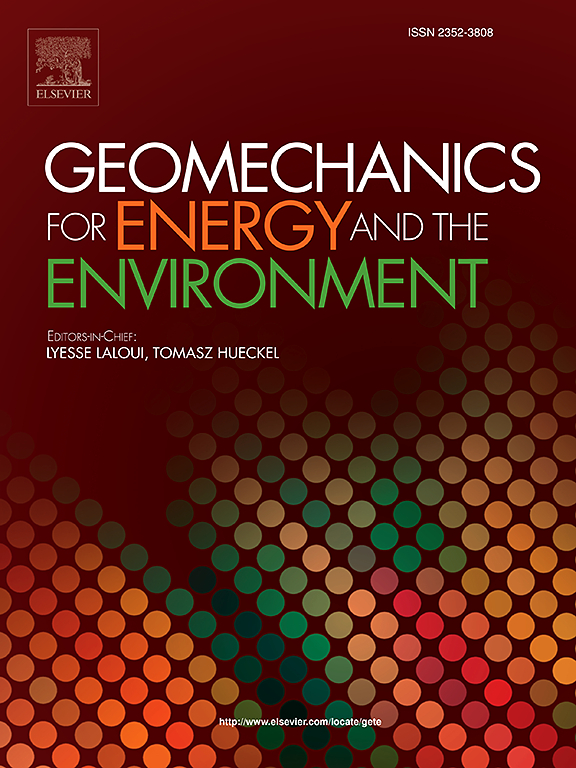热源道路集热与路面温度调节的三维数值模拟与分析
IF 3.7
2区 工程技术
Q3 ENERGY & FUELS
引用次数: 0
摘要
热活动道路是一种相对较新的、欠发达的能源土工结构。它包括两组水平放置在不同深度的管道,以在路面表面和地面之间交换热量。因此,热能可以在夏季储存在道路下方的土地上,并可以在冬季提取并用于加热路面,以减少冻融循环。本研究的重点是在COMSOL Multiphysics中开发详细的三维(3D)有限元(FE)模型,以探索热源道路的热性能。开发的三维有限元模型与在英国托丁顿进行的全尺寸现场测试的实验数据进行了广泛的验证。利用该模型进一步分析了土壤导热系数、管道埋深、流体流速和保温层对地热系统能量收集和提取效率的影响。在此基础上提出了系统优化方案。结果表明,储水管道埋深对能量收集效率的影响最大,储水管道埋深每增加1.6 m,蓄能量增加1.75倍。土壤热导率越高,系统的能量收集效率越高。当土壤导热系数从0.4增加到2.0 W⁄(m∙K)时,蓄能值从0.56增加到0.86 MWh。本研究表明,该系统可以调节道路温度,从而有可能防止夏季道路车辙和冬季冻融循环,延长其使用寿命。本文章由计算机程序翻译,如有差异,请以英文原文为准。
3D numerical modelling and analysis of heat harvesting and pavement temperature regulation of a thermo-active road
Thermo-active roads are a relatively new and underdeveloped type of energy geostructures. It involves two sets of horizontally placed pipes at different depths to exchange heat between the pavement surface and the ground. Thereby, thermal energy can be stored into the ground beneath the road in summer and can be extracted and used to heat up the road surface in winter to reduce freeze-thaw cycles. This research focuses on the development of a detailed three-dimensional (3D) finite-element (FE) model in COMSOL Multiphysics to explore the thermal performance of a thermo-active road. The 3D FE model developed was extensively validated against the experimental data from a full-scale field test undertaken in Toddington, UK. The validated model is further employed to analyse the effects of soil thermal conductivity, embedded depth of pipes, fluid flow rate and insulation layer on energy harvesting and extracting efficiency of the geothermal system. System optimisation is proposed based on the analysis. Results show that the embedded depth of storage pipes influences the energy harvesting efficiency the most, with energy storage increasing by 1.75 times when the embedded depth of storage pipes increased by 1.6 m. Higher soil thermal conductivity led to a higher energy harvesting efficiency of the system as well. The energy storage value increases from 0.56 to 0.86 MWh when soil thermal conductivity increased from 0.4 to 2.0 W⁄(m∙K). This research study indicates that this system can regulate road temperature, thereby potentially preventing road rutting in summer and freeze-thaw cycles in winter and extending its lifespan.
求助全文
通过发布文献求助,成功后即可免费获取论文全文。
去求助
来源期刊

Geomechanics for Energy and the Environment
Earth and Planetary Sciences-Geotechnical Engineering and Engineering Geology
CiteScore
5.90
自引率
11.80%
发文量
87
期刊介绍:
The aim of the Journal is to publish research results of the highest quality and of lasting importance on the subject of geomechanics, with the focus on applications to geological energy production and storage, and the interaction of soils and rocks with the natural and engineered environment. Special attention is given to concepts and developments of new energy geotechnologies that comprise intrinsic mechanisms protecting the environment against a potential engineering induced damage, hence warranting sustainable usage of energy resources.
The scope of the journal is broad, including fundamental concepts in geomechanics and mechanics of porous media, the experiments and analysis of novel phenomena and applications. Of special interest are issues resulting from coupling of particular physics, chemistry and biology of external forcings, as well as of pore fluid/gas and minerals to the solid mechanics of the medium skeleton and pore fluid mechanics. The multi-scale and inter-scale interactions between the phenomena and the behavior representations are also of particular interest. Contributions to general theoretical approach to these issues, but of potential reference to geomechanics in its context of energy and the environment are also most welcome.
 求助内容:
求助内容: 应助结果提醒方式:
应助结果提醒方式:


